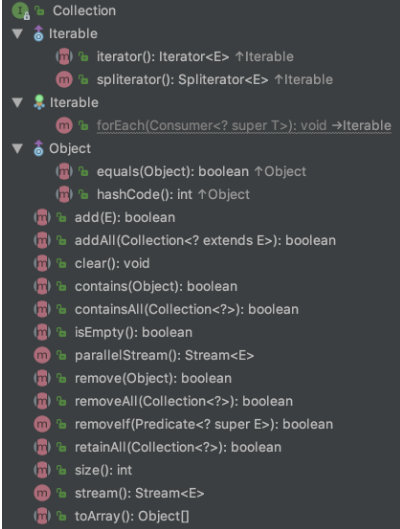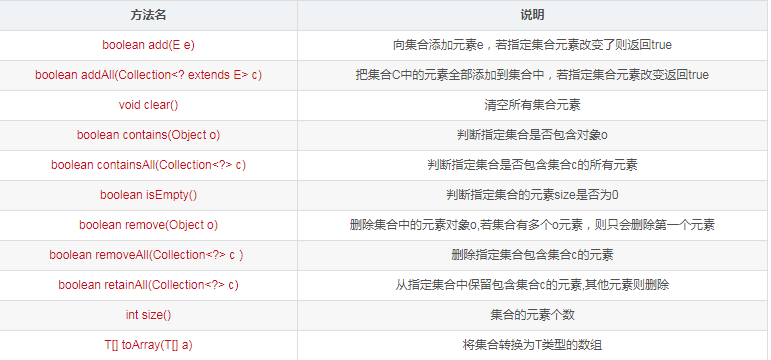更新时间:2020-08-07 16:21:49 来源:动力节点 浏览3870次
Collection方法接口介绍
Collection接口有3种子类型集合:List、Set和Queue,再下面是一些抽象类,最后是具体实现类,常用的有ArrayList、LinkedList、HashSet、LinkedHashSet、ArrayBlockingQueue等,下面是Collection的所有方法。

这些方法即可以操作Set集合,也可以操作Queue和List集合,下面分别使用Collection集合接口的方法说明

下面是主要方法的演示:
@Test
@SuppressWarnings("all")
public void testCollection() {
// 创建Collection接口的实现
Collection collection = new ArrayList<>();
// 添加元素
collection.add("嘻嘻");
String src = "????";
collection.add(src);
System.out.println(collection);
// 创建Collection的实现
Collection coll = new HashSet<>();
coll.add("?");
coll.add("?");
coll.add("?");
System.out.println(coll);
// 添加一个集合数据
collection.addAll(coll);
// 输出集合的长度
System.out.println(collection);
// 判断是否包含
System.out.println(collection.contains("?"));
// 移除元素
collection.remove("?");
// 添加对象
collection.add(new Person("张三", 23, 5000d));
// 当认为两个对象属性一致,相等时候,需重写hashCode 和 equals方法
System.out.println(collection.contains(new Person("张三", 23, 5000d)));
System.out.println("-------");
collection.add(null);
Collection collection1 = new ArrayList<>();
collection1.add("嘻嘻");
collection1.add("?");
// 求两个集合的交集(只保留collection1存在的元素)
collection.retainAll(collection1);
System.out.println(collection);
// 清空元素
collection.clear();
System.out.println(collection);
}
java8新特性操作集合
使用lambda表达式遍历集合
java8为Collection的父接口(Iterable)提供了一个默认的Foreach方法,我们可以使用它进行集合遍历
@Test
public void testForeach() {
Collection collection = new ArrayList<>();
collection.add("i");
collection.add("love");
collection.add("china");
// foreach遍历
collection.forEach(e-> System.out.println(e));
// 可以使用方法引用简写
collection.forEach(System.out::println);
// 或者迭代器的forEachRemaining方法
collection.iterator().forEachRemaining(System.out::println);
}
使用java8的predicate操作集合
@Test
public void testPredicate() {
Collection collection = new ArrayList<>();
// 添加0-49
for (int i = 0; i < 50; i++) {
collection.add(i);
}
// 移除10-49的数字
collection.removeIf(e -> (e > 9 && e < 50));
System.out.println(collection);// 输出[0, 1, 2, 3, 4, 5, 6, 7, 8, 9]
}
基于流操作集合
java8之后引入了Stream相关流操作java集合,通过流大大简化了对集合操作
@Test
public void testIntStream() {
Collection collection = new ArrayList<>();
Random random = new Random();
for (int i = 0; i < 10; i++) {
collection.add(random.nextInt(100));
}
System.out.println(collection);
// collection存储的数值是包装类型,可以将其转换为IntStream
IntStream intStream = collection.stream().mapToInt(e -> e);
// intStream.forEach(System.out::println);
System.out.println(collection.stream().mapToInt(e -> e).sum());
// 输出最大值
collection.stream().mapToInt(e -> e).max().ifPresent(System.out::println);
// 输出最小值
collection.stream().mapToInt(e -> e).min().ifPresent(System.out::println);
// 统计大于50的数
System.out.println(collection.stream().filter(e -> e > 50).count());
// 原集合每一个值加1
collection.stream().mapToInt(e-> e+1).forEach(System.out::println);
// 排序
collection.stream().mapToInt(e-> e).sorted().forEach(System.out::println);
// 原数值每一个元素扩大2倍
int[] ints = collection.stream().mapToInt(e -> e << 1).toArray();
// 输出原数组
System.out.println(Arrays.toString(ints));
// 将数组转流
IntStream stream = Arrays.stream(ints);
// 输出流平均数
System.out.println(stream.average().getAsDouble());
}
以上就是动力节点java培训机构的小编针对“Java中collection常用方法详解”的内容进行的回答,希望对大家有所帮助,如有疑问,请在线咨询,有专业老师随时为你服务。
 Java实验班
Java实验班
0基础 0学费 15天面授
 Java就业班
Java就业班
有基础 直达就业
 Java夜校直播班
Java夜校直播班
业余时间 高薪转行
 Java在职加薪班
Java在职加薪班
工作1~3年,加薪神器
 Java架构师班
Java架构师班
工作3~5年,晋升架构
提交申请后,顾问老师会电话与您沟通安排学习